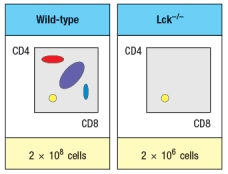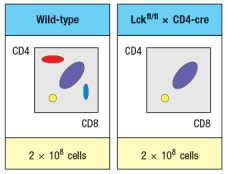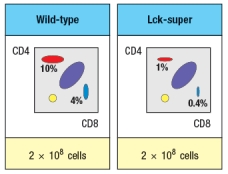Synthesis question: To investigate how T-cell receptor signaling regulates T cell development in the thymus, a mutant mouse is generated with a deficiency in the T cell tyrosine kinase, LCK (Lck-/- mice). Analysis of thymocytes from these mice, stained with antibodies to CD4 and CD8, is shown in Figure. 
a) What is the explanation for the altered number and subsets of thymocytes in Lck-/- mice?
Due to the defect observed in the germline Lck-deficient mice, it is not possible to use these mice to examine any potential role for this T-cell receptor signaling protein at later stages of thymocyte development. To circumvent this problem, conditional Lck-deficient mice are generated by crossing mice with a homozygous 'floxed' allele of Lck (Lckfl/fl) to mice that express the cre recombinase in CD4+CD8+ double-positive thymocytes (i.e., CD4-cre). When cre is expressed at the double-positive stage, the Lck gene is deleted, and thymocytes become Lck-deficient at that time. The thymocyte profile of these Lckfl/fl x CD4-cre mice is shown in Figure.

b) What is the explanation for the altered thymocyte profile seen in Lckfl/fl x CD4-cre mice?
To further assess the impact of altered T-cell receptor signaling on thymocyte development, another line of mice is generated that express a super-active version of the Lck kinase (called 'Lck-super') under control of the CD4 promoter. This super-active Lck is expressed starting at the double-positive stage in the thymus. Lck-super is activated by T-cell receptor signaling, just like wild-type Lck, but when activated has an approximately tenfold increased kinase activity. Surprisingly, mice expressing Lck-super do not develop increased numbers of mature T cells, but instead, show the following.

c) What is the most likely explanation for the altered profile of thymocytes seen in the Lck-super mice?
Struck by the findings in the Lck-super mice, an investigator performs one further experiment. This researcher clones the rearranged T-cell receptor and chain genes from two CD4 single-positive thymocytes: one that is isolated from a WT thymus, and the second, isolated from an Lck-super thymus. Each T-cell receptor : pair is used to generate a T-cell receptor transgenic line, so that nearly 100% of all double-positive thymocytes in each transgenic line express only the transgenic T-cell receptor. The two T cell receptor transgenics are named based on which mouse line the receptor chains were originally isolated from. The one from the wild-type line is known as TCR-tgwt, and the one originally isolated from the Lck-super line is known as TCR-tgsuper. In each case, thymocytes from the T-cell receptor transgenic lines are analyzed on a wild-type background, or after crossing to the Lck-super line. The results are shown in Figure.

d) Explain the results observed in this experiment.
Definitions:
Neurotransmitter Inhibitors
Substances or drugs that hinder the release, synthesis, or function of neurotransmitters, affecting communication between nerve cells.
Synaptic Gap
A tiny interval between neurons at a synapse, facilitating the transfer of an electrical or chemical signal.
Central Nervous System
The part of the nervous system consisting of the brain and spinal cord, responsible for processing and sending out information.
Reuptake
The absorption process of neurotransmitters by a neuron after it has transmitted a neural impulse, affecting communication within the brain.
Q1: An area of cancer immunotherapy that is
Q2: Expressed on osteoclasts,this receptor is important in
Q3: Cytotoxic T cells that lack expression of
Q4: Red blood cells are common targets
Q5: Low-affinity Ig receptor on natural killer cells
Q10: Which of the following is NOT an
Q14: Multiple mechanisms provide a series of checkpoints
Q14: The take-home pay of Jon Greene and
Q29: The MARCH-1 E3-ubiquitin ligase is expressed in
Q35: i. The cyclical component of a time